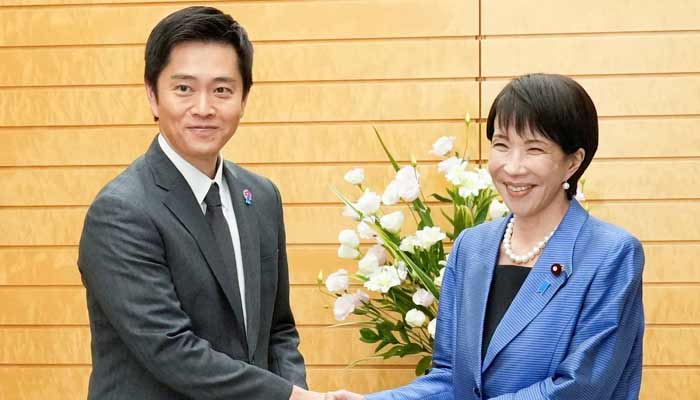Select Language:
Japan’s new Prime Minister Sanae Takaichi shakes hands with Hirofumi Yoshimura, head of the Japan Innovation Party—also known as Ishin—during their meeting at the official residence in Tokyo on October 21, 2025. — Reuters
– Takaichi makes history as Japan’s first female prime minister.
– Her election signifies a rightward political shift in Japan.
– Financial markets show optimism regarding Takaichi’s economic plans.
Hardline conservative Sanae Takaichi has been elected Japan’s first female prime minister, breaking a significant glass ceiling and signaling a move further to the right politically. An admirer of former Prime Minister Shinzo Abe and British Prime Minister Margaret Thatcher, Takaichi is expected to pursue an Abe-esque approach to economic stimulus in hopes of reviving an economy characterized by sluggish growth and rising inflation.
Although her victory is a historic milestone, she appointed only two women to her cabinet—fewer than she had initially promised. Her tenure is likely to bring a sharper focus on tough immigration policies and enhanced national defense, aligning her with the global shift toward right-leaning leadership. In the parliamentary vote, she secured 237 out of 465 votes in the lower house and claimed a similar victory in the upper house, which holds less power.
Her ascent was supported by the ruling Liberal Democratic Party (LDP), which agreed on Monday to form a coalition with the Japan Innovation Party, known as Ishin. Combined, these parties fall just two seats short of a majority in the lower house, meaning Takaichi will need to gain support from opposition members to stabilize her government, according to political analyst Tadashi Mori from Aichi Gakuin University.
Since the death of former Prime Minister Abe, Japan’s political landscape appears more divided than in recent memory, partly due to the rise of the small, far-right Sanseito Party, which has attracted voters away from the LDP. Sanseito leader Sohei Komiya expressed hope that Takaichi would steer Japan back toward the political center, even as his party remains prepared to oppose her policies if necessary. Additionally, the moderate Komeito, which had been allied with the LDP for 26 years, ended that partnership earlier this month following Takaichi’s appointment as the party leader.
Takaichi appointed just two women to her cabinet: Satsuki Katayama, who became Japan’s first female finance minister, and Kimi Onoda as the minister for economic security. During her campaign, she vowed to increase female representation in the cabinet to levels comparable with Nordic countries, where women hold 36% to 61% of ministerial positions—yet under her leadership, women will compose only 16% of the cabinet.
The prospects for a “Nordic-style” cabinet in Japan remain slim, reflecting persistent gender disparities. Experts like Yoko Otsuka from Ritsumeikan University suggest that while her appointment might marginally help Japan’s rank on the Global Gender Gap Index, the overall impact will be limited.
Market reactions to her economic platform have been significant, with the Nikkei reaching record highs partly driven by expectations of Abe-style fiscal stimulus policies. However, concerns about Japan’s substantial debt load, which exceeds its annual economic output, have caused the yen and bond prices to weaken. Reviving Abenomics could prove challenging since it was originally crafted to combat deflation, not inflation. Budget-conscious parties like Ishin may also impose constraints on Takaichi’s spending plans.
She emphasized that defense and national security would be central to her leadership, with plans to increase military expenditure and strengthen ties with the United States and other allies. She is also expected to visit the U.S. within her first week in office. Takaichi has been a controversial figure, often visiting the Yasukuni Shrine—viewed by neighboring countries as a symbol of Japan’s wartime past—and advocating for constitutional revisions to acknowledge Japan’s military forces.
Shinjiro Koizumi, a rising star in Japanese politics, will serve as defense minister, while veteran lawmaker Toshimitsu Motegi takes on the foreign affairs role. Takaichi is set to be sworn in as Japan’s 104th prime minister, succeeding Shigeru Ishiba, who resigned last month after election losses.






